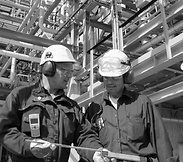Engineering and Technology Quarterly Reviews
ISSN 2622-9374




Published: 15 April 2023
The Major Obstacles and Factors Facing Green Building in the KSA: A Background Study
Tariq Al Amri, Naif Al Otaibi, Manuel Marey-Perez
Dhofar Academia (Oman), Santiago de Compostela University (Spain)

Download Full-Text Pdf
10.5281/zenodo.7829286
Pages: 22-33
Keywords: Green buildings, Circular Carbon Economy, Saudi Arabia, Project Management
Abstract
This research aims to highlight the obstacles to green buildings and reveal the factors that can help in reducing these obstacles. It uses a qualitative approach and collects data from previous studies. The results highlight that the literature on green buildings mentions barriers and obstacles in different categories, including financial, governmental, organizational, management, operational, technical, and socio-cultural barriers. Most of these barriers, directly and indirectly, affect the development of green buildings. To overcome these barriers, there are some important factors to be considered, including the introduction of new government rules and regulations, offering incentives to industry to encourage businesses, creating a collaborative culture among stakeholders to spread awareness and knowledge, information regarding green building, ensuring the sharing of success factors, and sharing of critical cases to add knowledge to others. Emphasis on these factors or strategies can help in the development of green buildings, which will lead to sustainable development in Saudi Arabia. Project managers can consider these results as guidelines to ensure sustainable development.
References
Ahmad, T., Aibinu, A. A., & Stephan, A. (2019). Managing green building development–a review of current state of research and future directions. Building and Environment, 155, 83-104.
Ahn, Y. H., Pearce, A. R., Wang, Y., & Wang, G. (2013). Drivers and barriers of sustainable design and construction: The perception of green building experience. International Journal of Sustainable Building Technology and Urban Development, 4(1), 35-45.
Alattyih, W., Haider, H., & Boussabaine, H. (2020). Risk factors impacting the project value created by green buildings in Saudi Arabia. Applied Sciences, 10(21), 7388.
Azeem, S., Naeem, M. A., Waheed, A., & Thaheem, M. J. (2017). Examining barriers and measures to promote the adoption of green building practices in Pakistan. Smart and Sustainable Built Environment, 6(3), 86–100.doi:10.1108/sasbe-06-2017-0023
Balasubramanian, S., & Shukla, V. (2017). Green supply chain management: the case of the construction sector in the United Arab Emirates (UAE). Production Planning & Control, 28(14), 1116–1138.doi:10.1080/09537287.2017.13416
Chan, A. P. C., Darko, A., & Ameyaw, E. E. (2017). Strategies for promoting green building technologies adoption in the construction industry—An international study. Sustainability, 9(6), 969.
Chan, A. P. C., Darko, A., Olanipekun, A. O., & Ameyaw, E. E. (2018). Critical barriers to green building technologies adoption in developing countries: The case of Ghana. Journal of Cleaner Production, 172, 1067–1079. doi: 10.1016/j.jclepro.2017.10.2
Chen, L., Chan, A. P., Owusu, E. K., Darko, A., & Gao, X. (2022). Critical success factors for green building promotion: A systematic review and meta-analysis. Building and Environment, 207, 108452.
Darko, A., & Chan, A. P. (2017). Review of barriers to green building adoption. Sustainable Development, 25(3), 167-179.
Darko, A., & Chan, A. P. C. (2016). Review of Barriers to Green Building Adoption. Sustainable Development, 25(3), 167–179. doi:10.1002/sd.1651
Darko, A., Chan, A. P. C., Yang, Y., Shan, M., He, B. J., & Gou, Z. (2018). Influences of barriers, drivers, and promotion strategies on green building technologies adoption in developing countries: The Ghanaian case. Journal of Cleaner Production, 200, 687-703.
Darko, A., Chan, A. P., Huo, X., & Owusu-Manu, D. G. (2019). A scientometric analysis and visualization of global green building research. Building and Environment, 149, 501-511.
Darko, A., Chan, A. P., Owusu, E. K., & Afari, M. F. A. (2018, April). Benefits of green building: a literature review. In RICS COBRA 2018.
Darko, A., Chan, A. P., Owusu-Manu, D. G., & Ameyaw, E. E. (2017). Drivers for implementing green building technologies: An international survey of experts. Journal of cleaner production, 145, 386-394.
Darko, A., Zhang, C., & Chan, A. P. (2017). Drivers for green building: A review of empirical studies. Habitat international, 60, 34-49.
G20 (Group of Twenty) Saudi Arabia. (2020a). Saudi Arabia 2020, Think-20—Communiqué, September 17 – November 1, 2020.
Goubran, S., & Cucuzzella, C. (2019). Integrating the sustainable development goals in building projects. Journal of sustainability research, 1(e190010), 1-43.
Gunduz, M., & Almuajebh, M. (2020). Critical success factors for sustainable construction project management. Sustainability, 12(5), 1990.
Hoffman, A. J., & Henn, R. (2008). Overcoming the social and psychological barriers to green building. Organization & Environment, 21(4), 390-419.
IEA (2022), Buildings, IEA, Paris https://www.iea.org/reports/buildings, License: CC BY 4.0.
Islam, M. M., Murad, M. W., McMurray, A. J., & Abalala, T. S. (2017). Aspects of sustainable procurement practices by public and private organisations in Saudi Arabia: an empirical study. International Journal of Sustainable Development & World Ecology, 24(4), 289-303.
Korkmaz, S., Horman, M., & Riley, D. (2009). Key attributes of a longitudinal study of green project delivery. In Construction Research Congress 2009: Building a Sustainable Future (pp. 558-567).
Li, Q., Long, R., Chen, H., Chen, F. and Wang, J., 2020. Visualized analysis of global green buildings: Development, barriers and future directions. Journal of Cleaner Production, 245, p.118775.
Li, Q., Long, R., Chen, H., Chen, F., & Wang, J. (2020). Visualized analysis of global green buildings: Development, barriers and future directions. Journal of Cleaner Production, 245, 118775.
McDonough, W. (2016). Carbon is not the enemy. Nature, 539(7629), 349-351.
Nain, A., Banerjee, A., & Melkania, N. P. (2021). Effects of Green Buildings on the Environment. Digital Cities Roadmap: IoT‐Based Architecture and Sustainable Buildings, 477-507.
Nguyen, H. D., & Macchion, L. (2022). Risk management in green building: a review of the current state of research and future directions. Environment, Development and Sustainability, 1-37.
Nguyen, H. T., Skitmore, M., Gray, M., Zhang, X., & Olanipekun, A. O. (2017). Will green building development take off? An exploratory study of barriers to green building in Vietnam. Resources, Conservation and Recycling, 127, 8-20.
Olanipekun, A. O., Chan, A. P., Xia, B., & Adedokun, O. A. (2018). Applying the self-determination theory (SDT) to explain the levels of motivation for adopting green building. International Journal of Construction Management, 18(2), 120-131.
Raouf, A. M., & Al-Ghamdi, S. G. (2020). Framework to evaluate quality performance of green building delivery: construction and operational stage. International Journal of Construction Management, 1-15.
Sabbagh, M. J., Mansour, O. E., & Banawi, A. A. (2019). Grease the Green Wheels: A Framework for Expediting the Green Building Movement in the Arab World. Sustainability, 11(20), 5545.
Schöggl, J.-P., Stumpf, L., & Baumgartner, R. J. (2020). The narrative of sustainability and circular economy - A longitudinal review of two decades of research. Resources, Conservation & Recycling, 163), https://doi.org/10.1016/j.resconrec.2020.105073
Statistics about Construction in Saudi Arabia (2022). Retrieves from https://www.statista.com/map/asia/saudi-arabia/construction
Teng, J., Zhang, W., Wu, X., & Zhang, L. (2016). Overcoming the barriers for the development of green building certification in China. Journal of Housing and the Built Environment, 31(1), 69-92.
Van Agt, C. (2020). Circular Carbon Economy Platform – Accelerator.’ IEF presentation at the G20 Energy Ministerial meeting. September 27, 2020.
Williams, E. (2019). Achieving Climate goals by closing the loop in a Circular Carbon Economy. Instant Insight, November 6, 2019. KAPSARC.
Williams, E. (2020a). CCE Guide: overview. A guide to the circular carbon economy (CCE). KAPSARC
Wirahadikusumah, R. D., & Ario, D. (2015). A readiness assessment model for Indonesian contractors in implementing sustainability principles. International Journal of Construction Management, 15(2), 126-136.
Zhao, X., Zuo, J., Wu, G., & Huang, C. (2019). A bibliometric review of green building research 2000–2016. Architectural Science Review, 62(1), 74-88.
Balabel, A., & Alwetaishi, M. (2021). Towards Sustainable Residential Buildings in Saudi Arabia According to the Conceptual Framework of “Mostadam” Rating System and Vision 2030. Sustainability, 13(2), 793.
Meena, C. S., Kumar, A., Jain, S., Rehman, A. U., Mishra, S., Sharma, N. K., ... & Eldin, E. T. (2022). Innovation in Green Building Sector for Sustainable Future. Energies, 15(18), 6631.
Abubakar, I. R., & Dano, U. L. (2020). Sustainable urban planning strategies for mitigating climate change in Saudi Arabia. Environment, Development and Sustainability, 22(6), 5129-5152.
Balabel, A., & Alwetaishi, M. (2021). Towards Sustainable Residential Buildings in Saudi Arabia According to the Conceptual Framework of “Mostadam” Rating System and Vision 2030. Sustainability, 13(2), 793.
World Summit on Sustainable Development, 26 August-4 September 2002, Johannesburg. Retrieved from https://www.un.org/en/conferences/environment/johannesburg2002.
Yi, M. T., & Yun, S. (2022, May). Saudi Arabia’s LEED Projects: Recent Green Building Trends and Perspective. In IOP Conference Series: Earth and Environmental Science (Vol. 1026, No. 1, p. 012062). IOP Publishing.
NABD. (2022, August 3). صحيفة أخبار الالكترونية | نمو متزايد تجاوز 380% على طلبات البناء المستدام خلال النصف الأول من 2022. (اخبار) (السعودية) [Electronic news newspaper | Increasing growth exceeding 380% on sustainable building requests during the first half of 2022. (News) (Saudi Arabia)]. Retrieved January 25, 2023, from https://nabd.com/s/107143115-5ec9f5/نمو-متزايد-تجاوز-380-على-طلبات-البناء-المستدام-خلال-النصف-الأول-من-2022
Shehri, T. A., Braun, J. F., Howarth, N., Lanza, A., & Luomi, M. (2022). Saudi Arabia’s climate change policy and the circular carbon economy approach. Climate Policy, 1-17.
IEA (International Energy Agency). (2020). World Energy Balances and Statistics. Accessed October 2020. https://www.iea.org/subscribe-to-data-services/world-energy-balances-and-statistics
Luomi, M., Yilmaz, F., & Alshehri, T. (2022). The Gulf Cooperation Council and the Circular Carbon Economy: Progress and Potential (No. ks--2022-dp06).
